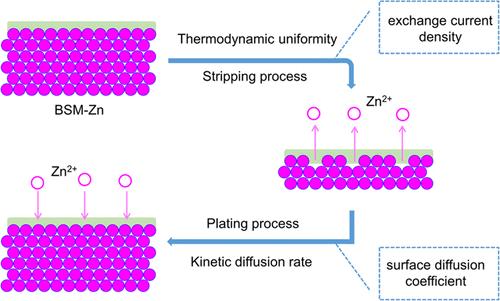Regulating the Thermodynamic Uniformity and Kinetic Diffusion of Zinc Anodes for Deep Cycling of Ah-Level Aqueous Zinc-Metal Batteries
IF 16
1区 材料科学
Q1 CHEMISTRY, MULTIDISCIPLINARY
引用次数: 0
Abstract
Zn metal anodes in mildly acidic electrolytes usually suffer from a series of problems, including parasitic dendrite growth and severe side reactions, significantly limiting the Zn utilization efficiency and cycling life. A deep understanding of the Zn stripping/plating process is essential to obtain high-efficiency and long-life Zn metal anodes. Here, the factors affecting the Zn stripping/plating process are revealed, suggesting that thermodynamic uniformity in bulk structures promotes an orderly Zn stripping process, and a fast kinetic diffusion rate on the Zn surface facilitates uniform Zn deposition. Then, a bulk and surface co-optimized strategy for stabilizing Zn metal anodes is proposed, which is confirmed to effectively suppress the Zn dendrite growth and side reactions. Thus, the modified Zn anodes display record-breaking cycling lives of 1200 and 200 h under ultrahigh Zn utilization efficiencies of 80 and 93.5%, respectively. More importantly, using this modified Zn metal anode enables us to realize Ah-level pouch cells for continuous cycles under harsh conditions.

调节ah级锌金属水电池深度循环中锌阳极的热力学均匀性和动力学扩散
在轻度酸性电解液中,锌金属阳极存在寄生枝晶生长和严重副反应等问题,严重限制了锌的利用效率和循环寿命。深入了解锌剥离/镀工艺是获得高效率和长寿命锌金属阳极的必要条件。本文揭示了影响锌剥离/镀过程的因素,表明体结构的热力学均匀性促进了锌剥离过程的有序进行,而锌表面快速的动力学扩散速率有利于锌的均匀沉积。然后,提出了一种稳定Zn金属阳极的体积和表面协同优化策略,并证实该策略可以有效抑制Zn枝晶生长和副反应。因此,改性锌阳极的循环寿命分别达到1200和200 h,锌利用率分别达到80%和93.5%。更重要的是,使用这种改性锌金属阳极使我们能够在恶劣条件下实现连续循环的ah级袋状电池。
本文章由计算机程序翻译,如有差异,请以英文原文为准。
求助全文
约1分钟内获得全文
求助全文
来源期刊

ACS Nano
工程技术-材料科学:综合
CiteScore
26.00
自引率
4.10%
发文量
1627
审稿时长
1.7 months
期刊介绍:
ACS Nano, published monthly, serves as an international forum for comprehensive articles on nanoscience and nanotechnology research at the intersections of chemistry, biology, materials science, physics, and engineering. The journal fosters communication among scientists in these communities, facilitating collaboration, new research opportunities, and advancements through discoveries. ACS Nano covers synthesis, assembly, characterization, theory, and simulation of nanostructures, nanobiotechnology, nanofabrication, methods and tools for nanoscience and nanotechnology, and self- and directed-assembly. Alongside original research articles, it offers thorough reviews, perspectives on cutting-edge research, and discussions envisioning the future of nanoscience and nanotechnology.
 求助内容:
求助内容: 应助结果提醒方式:
应助结果提醒方式:


